Impact of Implementing Circular Waste Management System and Energy Recovery in a City with 100,000 Inhabitants on Nitrogen Emissions by 2035
Abstract
:1. Introduction
2. Materials and Methods
2.1. Waste Management in a City with a Population of 100,000 in 2020–2035
2.2. Forecast of Changes in the Volume of Municipal Waste Streams from a Large City in the Years 2020–2035
- Composting of bio-waste—50%;
- Methane fermentation of bio-waste—38%, aerobic stabilization of digestate—12%;
- oxygen stabilization of OFMSW: kitchen and garden waste—50%, paper—15%, and wood and textiles—5%;
- anaerobic stabilization of OFMSW, kitchen and garden waste—38% and aerobic stabilization of digestate—12%.
3. Results
3.1. Analysis of the Flow of Waste Streams in the Waste Management System
3.2. Nitrogen Flow in Waste Management from 2020 to 2035
4. Discussion
- CB—COF variant: selectively collected bio-waste is composted, and OFMSW (the <80 mm fraction separated from residual municipal waste in the existing MBT plant), is stabilized under aerobic conditions;
- CB—ADOF + AS system: selectively collected bio-waste is composted, and OFMSW is stabilized under anaerobic conditions;
- ADB + AS—COF system: selectively collected bio-waste is treated under anaerobic–oxygen conditions, and OFMSW is stabilized under aerobic conditions;
- ADB + AS—ADOT + AS system: selectively collected bio-waste and OFMSW are treated under anaerobic–oxygen conditions.
5. Conclusions
- Taking into account the magnitude of nitrogen emissions, the goals of the Waste Directive and the need to increase the share of obtaining energy from renewable sources, it can be concluded that the most favorable waste management option for the city of one hundred thousand is a system in which both the separately collected bio-waste and OFMSW are treated under anaerobic–aerobic conditions (ADB + AS—ADOF + AS variant).
- For economic and technical reasons, it is more favorable to choose the ADB + AS—COF variant, in which the selectively collected bio-waste is treated under anaerobic conditions, and OFMSW is stabilized under aerobic conditions in the existing MBT facility. Although biogas production in 2035 will be 27% lower, there will be no need to reconstruct the biological part of the existing MBT plant, and nitrogen emissions in wastewater will be lower by about 50%, and biogas will be lower by 25%.
- Variants with methane fermentation are characterized by a high nitrogen content in wastewater. A good direction of action in this area is the development of recycling or recovery technologies for nitrogen contained in wastewater.
Supplementary Materials
Author Contributions
Funding
Data Availability Statement
Conflicts of Interest
References
- Yu, K.; Li, S.; Sun, X.; Kang, Y. Maintaining the ratio of hydro soluble carbon and nitrogen within the optimal range to accelerate green waste composting. Waste Manag. 2020, 105, 405–413. [Google Scholar] [CrossRef] [PubMed]
- Jędrczak, A. Report on the Composition of Municipal Waste in Zielona Góra in 2020; University of Zielona Góra: Zielona Góra, Poland, 2021. [Google Scholar]
- Directive (EU) 2018/851 of the European Parliament and of the Council of 30 May 2018 Amending Directive 2008/98/EC on Waste. Available online: https://www.eea.europa.eu/policy-documents/directive-eu-2018-851-of (accessed on 1 February 2022).
- Heo, N.H.; Park, S.C.; Kang, H. Effects of mixture ratio and hydraulic retention time on single-stage anaerobic co-digestion of food waste and waste activated sludge. J. Environ. Sci. Health Part A 2004, 39, 1739–1756. [Google Scholar] [CrossRef] [PubMed]
- Adhikari, B.K.; Barrington, S.; Martinez, J. Predicted growth of world urban food waste and methane production. Waste Manag. Res. 2006, 24, 421–433. [Google Scholar] [CrossRef] [PubMed]
- Li, R.; Chen, S.; Li, X.; Saifullah Lar, J.; He, Y.; Zhu, B. Anaerobic codigestion of kitchen waste with cattle manure for biogas production. Energy Fuel 2009, 23, 2225–2228. [Google Scholar] [CrossRef]
- Jędrczak, A. Properties of the organic fraction directed to biostabilization in MBT installations during the heating season. Civ. Environ. Eng. 2018, 28, 65–78. [Google Scholar] [CrossRef]
- Mia, S.; Uddin Md, E.; Kader, M.A.; Ahsan, A.; Mannan, M.A.; Hossain, M.M.; Solaiman, Z.M. Pyrolysis and co-composting of municipal organic waste in Bangladesh: A quantitative estimate of recyclable nutrients, greenhouse gas emissions, and economic benefits. Waste Manag. 2018, 75, 503–513. [Google Scholar] [CrossRef] [PubMed]
- Zhou, Z.; Tang, Y.; Dong, J.; Chi, Y.; Ni, M.; Li, N.; Zhang, Y. Environmental performance evolution of municipal solid waste management by life cycle assessment in Hangzhou, China. J. Environ. Manag. 2018, 227, 23–33. [Google Scholar] [CrossRef]
- Parnaudeau, V.; Génermont, S.; Hénault, C.; Farrugia, A.; Robert, P. Nicolardot. Measured and Simulated Nitrogen Fluxes after Field Application of Food-Processing and Municipal Organic Wastes. J. Environ. Qual. 2009, 38, 268–280. [Google Scholar] [CrossRef]
- Suddick, E.C.; Whitney, P.; Townsend, A.R.; Davidson, E.A. The role of nitrogen in climate change and the impacts of nitrogen–climate interactions in the United States: Foreword to thematic issue. Biogeochemistry 2013, 114, 1–10. [Google Scholar] [CrossRef]
- Barton, P.K.; Atwater, J.W. Nitrous Oxide Emissions and the Anthropogenic Nitrogen in Wastewater and Solid Waste. J. Environ. Eng. 2002, 128, 138–147. [Google Scholar] [CrossRef]
- Beck-Friis, B.; Smårs, S.; Jönsson, H.; Kirchmann, H. Gaseous Emissions of Carbon Dioxide, Ammonia and Nitrous Oxide from Organic Household Waste in a Compost Reactor under Different Temperature Regimes. J. Agric. Eng. Res. 2001, 78, 423–430. [Google Scholar] [CrossRef]
- SP, 2021: Environment 2021. Available online: https://stat.gov.pl/en/topics/environment-energy/environment/environment-2021,8,4.html (accessed on 23 August 2022).
- Markic, D.N.; Carapina, H.S.; Bjelic, D.; Bjelic, L.S.; Ilic, P.; Pesic, Z.S.; Kikanovicz, O. Using Material Flow Analysis for Waste Management Planning. Pol. J. Environ. Stud. 2019, 28, 255–265. [Google Scholar] [CrossRef] [PubMed]
- SP 2022: Municipal Population Forecast for 2017–2030 (Experimental Study). Available online: https://stat.gov.pl/obszary-tematyczne/ludnosc/prognoza-ludnosci/prognoza-ludnosci-gmin-na-lata-2017-2030-opracowanie-eksperymentalne,10,1.html (accessed on 23 August 2022).
- Department for Environment, Food & Rural Affairs. Review of Environmental and Health Effects of Waste Management: Municipal Solid Waste and Similar Wastes, DEFRA, London. 2004. Available online: https://www.gov.uk/government/publications/review-of-environmental-and-health-effects-of-waste-management-municipal-solid-waste-and-similar-wastes (accessed on 1 January 2021).
- Thomé-Kozmiensky, K.J. Biologische Abfallbehandlung; EF-Verlag für Energie-und Umwelttechnik: Berlin, Germany, 1995. [Google Scholar]
- Loll, U. Sickerwasser aus Kompostierungs-und Anaerobanlagen. Entsorg. Prax. 2006, 7–8, 52–58. [Google Scholar]
- Phong, N.T. Greenhouse Gas Emissions from Composting and Anaerobic Digestion Plants. Inaugural Dissertation. Institut für Nutzpflanzenwissenschaften und Ressourcenschutz (INRES) Lehr-und Forschungsbereich Pflanzenernährung der Rheinischen Friedrich-Wilhelms-Universität zu Bonn. 2012. Available online: https://d-nb.info/104305586X/34 (accessed on 1 March 2021).
- Smet, E.; Van Langenhove, H.; De Bo, I. The emission of volatile compounds during the aerobic and the combined anaerobic/aerobic composting biowaste. Atmos. Environ. 1999, 33, 1295–1303. [Google Scholar] [CrossRef]
- Doedens, H. Emissionen aus der Mechanisch-Biologischen Abfallbehandlung, w: Müll-Handbuch; Springer: Berlin/Heidelberg, Germany, 2002; Volume 9, pp. 1–23. [Google Scholar]
- European Commission. Integrated Pollution Prevention and Control Reference Document on Best Available Techniques for the Waste Treatments Industries; European Commission: Luxembourg, 2006. [Google Scholar]
- Cencic, O.; Rechberger, H. Material Flow Analysis with Software STAN. J. Environ. Eng. Manag. 2008, 18, 3–7. [Google Scholar]
- Tang, J.; Brunner, P.H. Globalising MFA-Decision Support for Waste Management in Cities Based on the Software STAN; International Solid Waste Association (ISWA): Rotterdam, The Netherlands, 2014. [Google Scholar]
- Allesch, A.; Brunner, P.H. Material Flow Analysis as a Tool to Improve Waste Management Systems: The Case of Austria. Environ. Sci. Technol. 2017, 51, 540–551. [Google Scholar] [CrossRef]
- Thushari, I.; Vicheanteab, J.; Janjaroen, D. Material flow analysis and life cycle assessment of solid waste management in urban green areas, Thailand. Sustain. Environ. Res. 2020, 30, 21. [Google Scholar] [CrossRef]
- Den Boer, E.; den Boer, J.; Jager, J. Planowanie i Optymalizacja Gospodarki Odpadami. In Podręcznik Prognozowania Ilości i Jakości Odpadów Komunalnych Oraz Oceny Zgodności Systemów Gospodarki Odpadami z Zasadami Zrównoważonego Rozwoju; PZITS Oddz: Wrocław, Poland, 2005. [Google Scholar]
- Połomka, J.; Jędrczak, A. Efficiency of waste processing in the MBT system. Waste Manag. 2019, 96, 9–14. [Google Scholar] [CrossRef]
- Favoino, E. Building a bridge strategy for residual waste. Material recovery and biological treatment to manage residua waste within a circular economy. Policy Brief 2020. Available online: https://majorprojects.planningportal.nsw.gov.au/prweb/PRRestService/mp/01/getContent?AttachRef=SUB-11169426%2120201116T062622.468%20GMT (accessed on 1 March 2021).
- Münnich, K.; Mahler, C.F.; Fricke, K. Pilot project of mechanical-biological treatment of waste in Brazil. Waste Manag. 2006, 26, 150–157. [Google Scholar] [CrossRef]
- Righetto, I.; Al-Juboori, R.A.; Kaljunen, J.U.; Huynh, N.; Mikola, A. Nitrogen Recovery from Landfill Leachate Using Lab- and Pilot-Scale Membrane Contactors: Research into Fouling Development and Membrane Characterization Effects. Membranes 2022, 12, 837. [Google Scholar] [CrossRef] [PubMed]
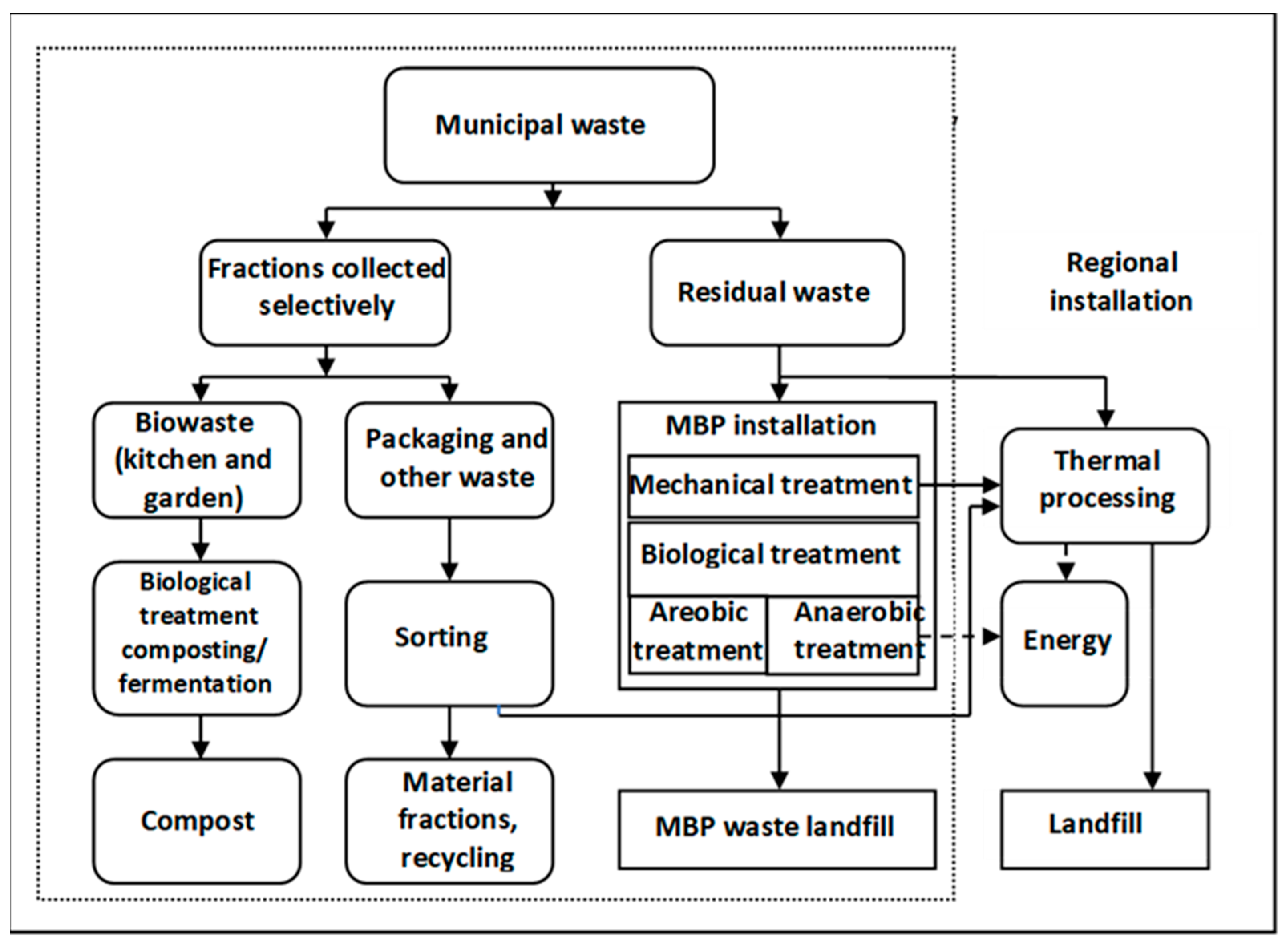





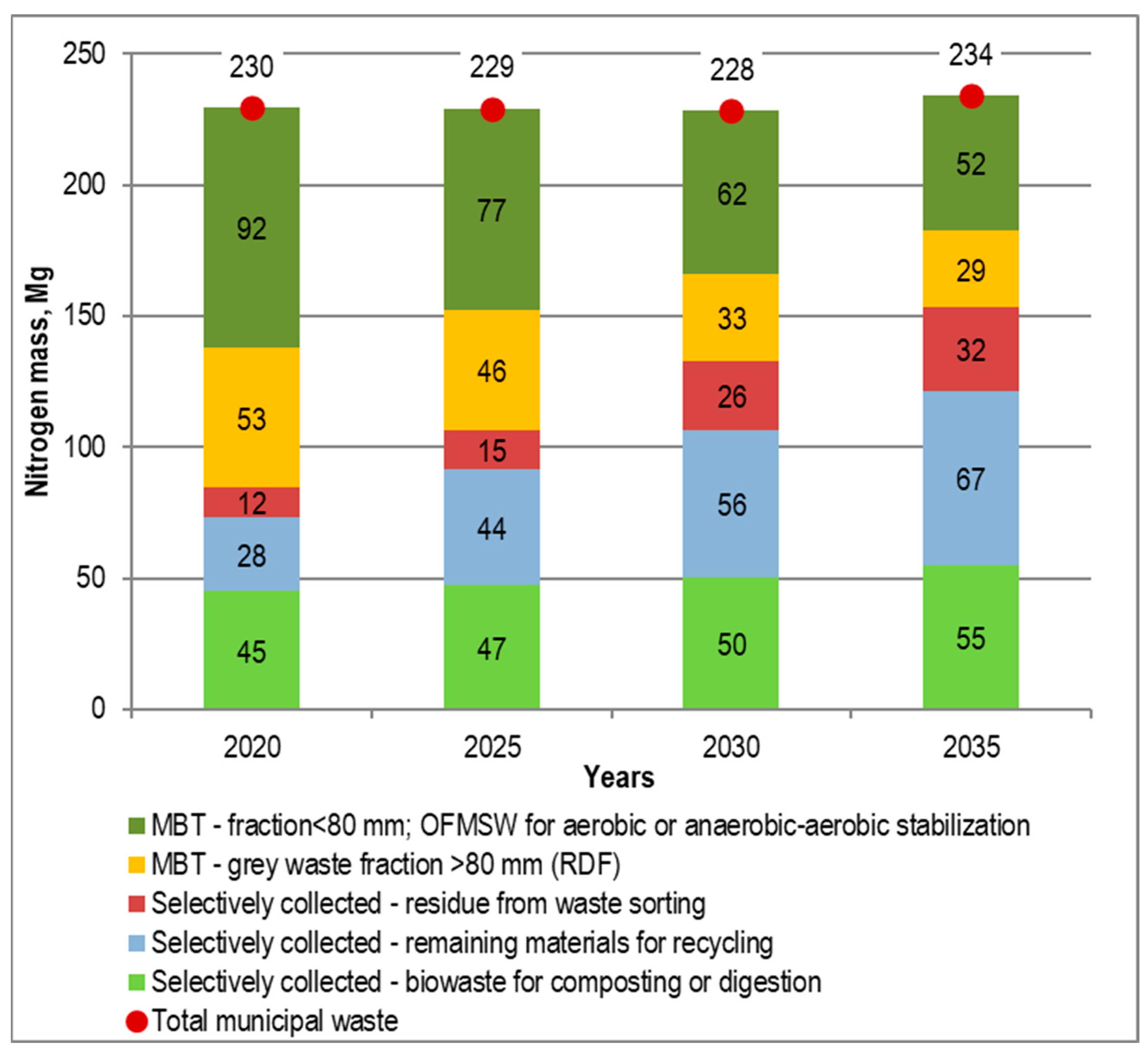

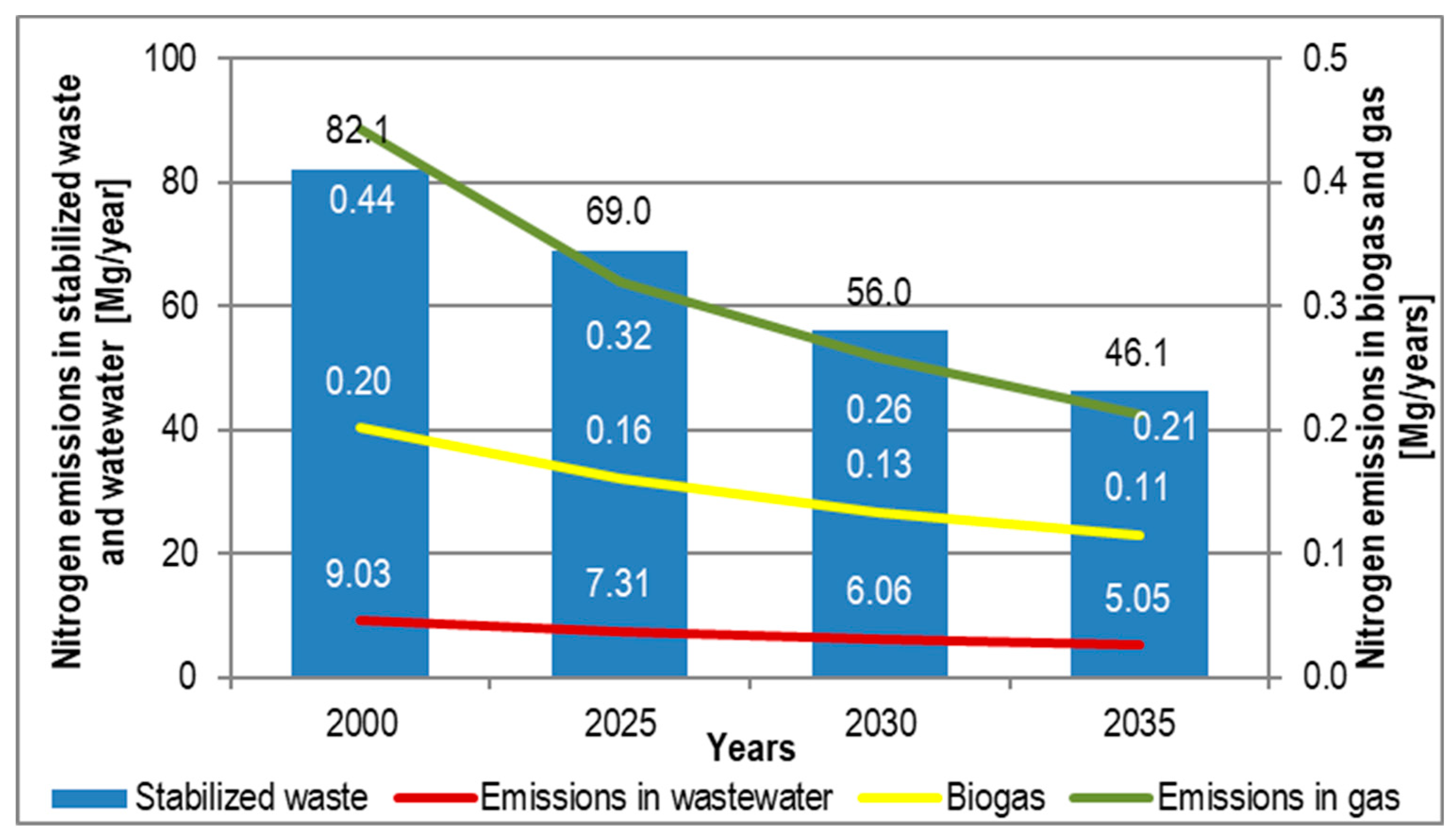
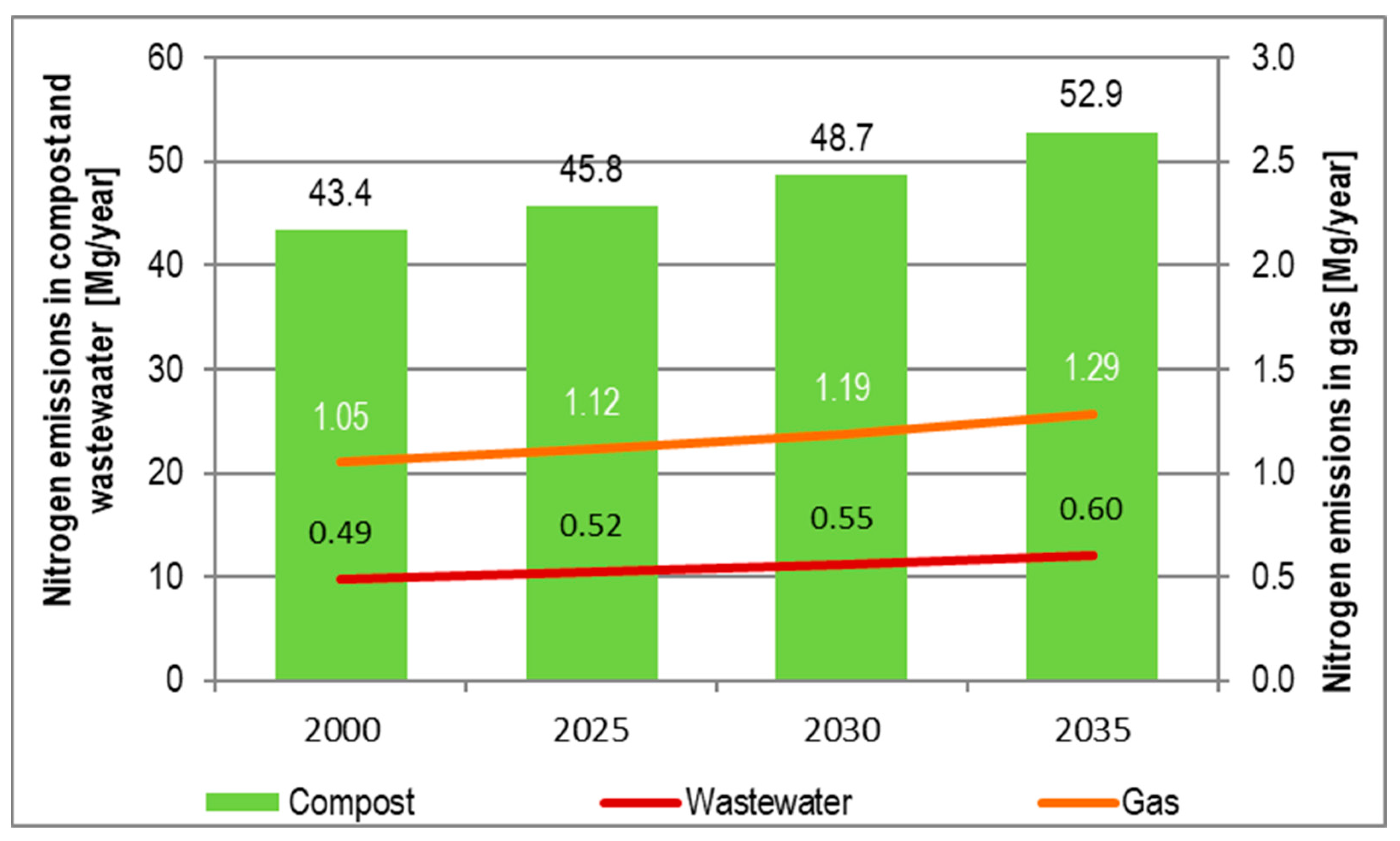

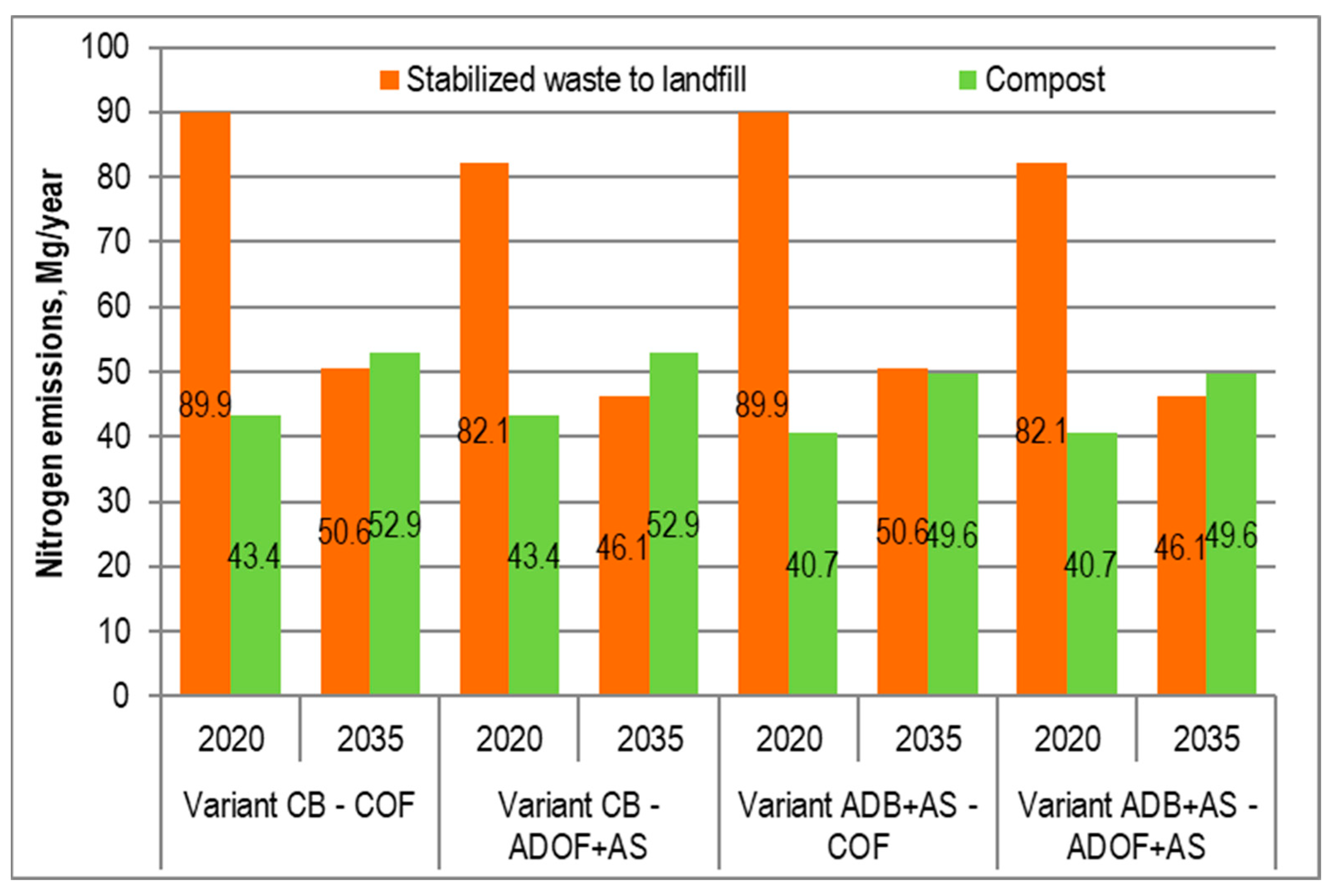

| Parameter | Participation of the Component in the Mass of MSW [2] | Generation Rate per Capita [2] | Selective Collection Levels [14] | Moisture [15] | Ignition Losses [15] | Total Nitrogen [15] |
|---|---|---|---|---|---|---|
| % | kg/(PE·Year) | % | % | % DM | % DM | |
| Kitchen waste | 21.8 | 86.3 | 37.3 | 55 | 87 | 1.7 |
| Garden waste | 11.6 | 46.0 | 72.8 | 57 | 84 | 1.2 |
| Paper and cardboard | 15.3 | 60.3 | 33.7 | 38 | 87 | 0.2 |
| Multi-material packaging | 1.4 | 5.7 | 14.7 | 25 | 91 | 2.5 |
| Plastics | 15.0 | 59.1 | 23.5 | 15 | 95 | 0 |
| Glass | 9.7 | 38.3 | 43.7 | 5 | 3 | 0 |
| Metal | 2.1 | 8.3 | 12.8 | 10 | 10 | 0 |
| Clothing. textiles | 3.0 | 11.7 | 0.7 | 30 | 85 | 3.6 |
| Wood | 0.6 | 2.5 | 0.1 | 20 | 90 | 0.2 |
| Hazardous waste | 0.2 | 0.7 | 31.4 | 25 | 50 | 0.2 |
| Mineral waste. including the ash fraction | 4.2 | 16.8 | 15.1 | 44 | 46 | 6.3 |
| Mineral waste | 1.6 | 6.3 | 41.9 | 10 | 5 | 0 |
| Other | 7.4 | 29.1 | 25.2 | 20 | 30.0 | 0.5 |
| Bulky waste | 6.1 | 24.1 | 60.0 | 10 | 50.0 | 0.8 |
| Municipal waste | 100.0 | 395.0 | 36.9 | 32.9 | 63.3 | 0.87 |
| Parameter | Ratio Values in Years, in [%] | |||
|---|---|---|---|---|
| 2020 * | 2025 | 2030 | 2035 | |
| Kitchen waste | 40.5 | 44.4 | 49.2 | 54.7 |
| Green waste | 76.6 | 84.2 | 89.5 | 94.7 |
| Paper and cardboard | 37.4 | 83.3 | 94.4 | 94.4 |
| Multi-material packaging | 18.4 | 37.5 | 56.3 | 62.5 |
| Plastics | 39.2 | 83.3 | 91.7 | 91.7 |
| Glass | 48.6 | 77.8 | 83.3 | 83.3 |
| Metal | 13.5 | 73.7 | 84.2 | 84.2 |
| Clothing. Textiles | 0.8 | 17.6 | 29.4 | 35.3 |
| Wood | 0.2 | 27.8 | 33.3 | 33.3 |
| Hazardous waste | 36.9 | 58.8 | 70.6 | 82.4 |
| Mineral waste. including the ash fraction | 8.9 | 25.0 | 31.3 | 37.5 |
| Mineral waste | 34.5 | 76.9 | 84.6 | 92.3 |
| Other | 38.8 | 53.8 | 61.5 | 84.6 |
| Bulky waste | 100.0 | 100.0 | 100.0 | 100.0 |
| Achieved level of PfR and MSW recycling | 36.2 | 55.0 | 61.4 | 65.1 |
| Process | Bio-Waste Treatment | OFMSW Treatment in the MBT Installation | |||||||
|---|---|---|---|---|---|---|---|---|---|
| The Amount of Sewage [m3/Mg] | Concentration of NH3 [gN/m3] | NH3 Emissions in Sewage [kgN/Mg] | Emission in Gases [kgN/Mg] | The Amount of Sewage [m3/Mg] | Concentration of NH3 [gN/m3] | NH3 Emissions in Sewage [kgN/Mg] | Emission in Gases [kgN/Mg] | ||
| Composting | 0.1–0.2 [17] | 100–633 [18] 209–470 [19] | - | 0.052– 0.576 [20] 0.152 [21] | 0.26–0.47 [22] 0.26 [17] | 70–875 [18] 60–125 [19] | 0.160 [17] | 0.300–1.00 [22] 0.12 [23] | |
| Parameters adopted for the calculations | 0.2 | 350 | 0.070 | 0.15 | 0.30 | 250 | 0.075 | 0.12 | |
| Methane fermentation | Biogas | - | - | - | 0.05 * | - | - | - | 0.04 * |
| Digestate dewatering | - | 560–1490 [19] | - | - | - | 560–1490 [19] | - | - | |
| Parameters adopted for the calculations | - | 800 | - | - | - | 800 | - | - | |
| Aerobic stabilization of the digestate | - | - | 0.0073 [17] −0.16 [23] | 0.041 [21] | - | 0.0073 [17] −0.16 [23] | 0.041 [21] | ||
| Parameters adopted for the calculations | 0.1 | 250 | 0.025 | 0.041 | 0.1 | 250 | 0.025 | 0.041 | |
Disclaimer/Publisher’s Note: The statements, opinions and data contained in all publications are solely those of the individual author(s) and contributor(s) and not of MDPI and/or the editor(s). MDPI and/or the editor(s) disclaim responsibility for any injury to people or property resulting from any ideas, methods, instructions or products referred to in the content. |
© 2023 by the authors. Licensee MDPI, Basel, Switzerland. This article is an open access article distributed under the terms and conditions of the Creative Commons Attribution (CC BY) license (https://creativecommons.org/licenses/by/4.0/).
Share and Cite
Suchowska-Kisielewicz, M.; Jędrczak, A. Impact of Implementing Circular Waste Management System and Energy Recovery in a City with 100,000 Inhabitants on Nitrogen Emissions by 2035. Energies 2024, 17, 108. https://doi.org/10.3390/en17010108
Suchowska-Kisielewicz M, Jędrczak A. Impact of Implementing Circular Waste Management System and Energy Recovery in a City with 100,000 Inhabitants on Nitrogen Emissions by 2035. Energies. 2024; 17(1):108. https://doi.org/10.3390/en17010108
Chicago/Turabian StyleSuchowska-Kisielewicz, Monika, and Andrzej Jędrczak. 2024. "Impact of Implementing Circular Waste Management System and Energy Recovery in a City with 100,000 Inhabitants on Nitrogen Emissions by 2035" Energies 17, no. 1: 108. https://doi.org/10.3390/en17010108
APA StyleSuchowska-Kisielewicz, M., & Jędrczak, A. (2024). Impact of Implementing Circular Waste Management System and Energy Recovery in a City with 100,000 Inhabitants on Nitrogen Emissions by 2035. Energies, 17(1), 108. https://doi.org/10.3390/en17010108







